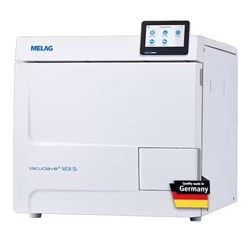The term steriliser applies to a wide range of devices used to eliminate all forms of microbial life, including bacteria, viruses, fungi, and spores, from surfaces, instruments, or other items. They are essential in various industries, including healthcare, pharmaceuticals, food processing, and laboratories. Industrial sterilisers in the medical industry are called autoclaves and they are quicker and better at cleaning instruments and the process is more controlled.
Autoclaves work on the principle of moist heat sterilisation. Steam is generated within the autoclave chamber, creating a high-pressure environment that penetrates materials and effectively kills microorganisms by denaturing their proteins and disrupting their cell membranes.
The key features of a quality autoclave are maintaining specific pressures and temperatures, a range of sterilisation cycles for different types of materials and applications, load configurations that allow steam to penetrate items evenly, and adequate safety features to protect users. Validation and monitoring of pressures and temperatures along with tracking maintenance and calibration are also needed to ensure consistent and reliable sterilisation.
Some autoclaves cost a couple of thousand dollars while others cost several times that amount. Consider the following before buying your next autoclave:
The Differences Between Class B, S and N Autoclaves
One key distinction between autoclaves lies in their air removal methods before sterilisation. Class B autoclaves employ a fractionated pre-vacuum pump to thoroughly extract air from the chamber, enhancing steam penetration into the load. Class N autoclaves rely on steam generated from a boiler or generator to displace air downwards, expelling it from the chamber.
Class N autoclaves can only sterilise solid instruments and do not dry items. They cannot sterilise hollow-body objects or anything in pouches. This is the lowest class of autoclaves.
Class B autoclaves are the most modern and advanced autoclave types that pass all sterilisation requirements for hospitals, medical centres and dentists. They can sterilise complex batches of items effectively and efficiently.
Class S autoclaves are an intermediary between Class N and Class B autoclaves. Like Class B, they pump out all the air before starting the sterilisation process but use a single-stage pre-vacuum, which is less effective. Class S autoclaves can do single-packed multilayering and larger instruments.
Considerations When Purchasing a New Steriliser
- Only buy from established manufacturers. A warranty is only good if the manufacturer is still in business to honour it. A well made steriliser should last at least 10 + years.
- Make sure the device is made from quality components that conform to Australian Standard AS 5369:2023.
- Ensure skilled technicians and spare parts availability support the device. Read reviews from people who needed technical support and had warranty issues.
- Ensure the installing company is accredited to the brand they are installing and is up to date with the new Australian Standard AS 5369:2023.
- Compare the number of cycles and years required for maintenance as this can affect the longevity and associated costs of the device.
- Consider the added benefits of automated door-locking and release, water-fill function, digital documentation and pre-programmed cycles.

Autoclaves Supported by SSS Australia
Melag series of Class S autoclaves
The newest Melag Pro-Line S Autoclaves are designed and manufactured in Germany and have a host of advanced features while still being competitively priced. Notable features include intuitive smart-touch displays and integrated USB and network interfaces for streamlined data logging. The 17-litre version can sterilise 5 trays and up to 4kg of instruments, while the 23-litre version accommodates 5 long trays (45cm) and 5kg loads in under 25 minutes.
Kronos series of Class B and Class S autoclaves
Connect with our Personal Account Managers if you need help choosing the right steriliser for your business.